10 Best HIIT Workout Apps in 2025

Crush your fitness goals with the best HIIT workout app picks of 2025, top-rated apps for fast, effective, and motivating home workouts.
Squeezing workouts into a busy day and wanting real results makes picking a HIIT app among the many Best Fitness Apps feel like a chore. Do you enjoy interval training that burns calories quickly, guided sessions you can follow at home, or programs that adapt to your increasing strength and stamina?
This guide breaks down interval timers, Tabata and circuit-style sessions, coach-led routines, workout libraries, wearable integration, and progress tracking, so you can confidently find and use a HIIT app that matches your lifestyle and fitness goals.
GetFit AI, an AI fitness app, makes that search easier by recommending tailored HIIT workouts, simple timers, music sync, and precise progress tracking so you stick with a plan. It guides beginners through safe moves, scales intensity for advanced intervals, and fits short cardio or strength circuits into your day.
Summary
- Adaptive, recovery-aware programs drive measurable gains, with coaching frameworks built around 8- to 12-week cycles, preventing the common plateau that typically appears by the fourth week.
- Short, low-friction sessions compound into a habit, with apps that enable 3 to 5 workouts per week via short, no-equipment formats, yielding better long-term adherence than sporadic, long sessions.
- Social formats and visible performance tracking sustain engagement, as demonstrated by platforms with around 2,000,000 active users per month, which maintain motivation through community feedback and leaderboards.
- Physiological benefits from well-programmed HIIT are rapid, with controlled studies reporting up to a 15 percent improvement in aerobic capacity after just 8 weeks of targeted intervals.
- The primary failure mode is technique collapse, not a lack of effort, and objective declines, such as a greater than 10 percent drop in pace or power across repeats, reliably signal the need to back off intensity to avoid injury.
- HIIT is efficient, working in constrained spaces as small as 2 by 2 meters and in brief windows, with proper protocols possible in as little as 10 minutes. 20-minute sessions can burn up to 300 calories.
- This is where GetFit AI's AI fitness app fits in; it addresses these needs by adjusting interval prescriptions and recovery checks from biometric trends, offering short, portable sessions, and clear objective feedback so workouts align with both daily constraints and progressive goals.
10 Best HIIT Workout Apps in 2025
These ten apps form a clear spectrum: some prioritize elite-level, data-driven progression, while others prioritize accessibility, live energy, or specialty formats like boxing. Pick by the outcome you want, measurable strength and technique gains, simple bodyweight conditioning, or group-driven motivation, and you will find a distinct winner among them.
1. GetFit AI

GetFit AI ranks among the best HIIT workout apps in 2025, distinguished by its AI-powered training experience that combines world-class, athlete-inspired routines with real-time, conversational coaching. Users benefit from personalized plans that evolve based on individual progress and biometric data, guided by AI versions of legends like Schwarzenegger and Ronaldo. Its blend of elite program access, interactive AI support, and detailed performance tracking makes it a standout for those aiming to maximize workout effectiveness safely.
Key Features
- AI-generated personalized HIIT workout plans adapting continuously to progress, health metrics, and goals
- Authentic elite athlete training routines customized for safety and effectiveness
- Conversational AI coach offering motivation, technique explanations, and pacing guidance
- Comprehensive progress tracking with strength curves, body composition trends, and performance analytics
- Integration with smartphones and fitness trackers for automated monitoring and adjustment
Pros
- Unique access to proven elite athlete training methods plus personalized coaching
- Authentic, adaptive AI mentorship rather than generic scripted advice
- Tracks meaningful fitness metrics to avoid plateaus and honestly measure progress
- Provides motivational and educational support during workouts
- Affordable alternative to in-person personal trainers with premium coaching quality
Best For
- Fitness enthusiasts who want to train based on elite athlete templates
- Users seeking a data-driven, highly personalized workout experience
- Individuals desiring interactive AI coaching with form and technique guidance
- Those balancing advanced programming with injury prevention
- Anyone aiming to enhance workouts through scientifically-backed progression and motivation
2. Nike Training Club
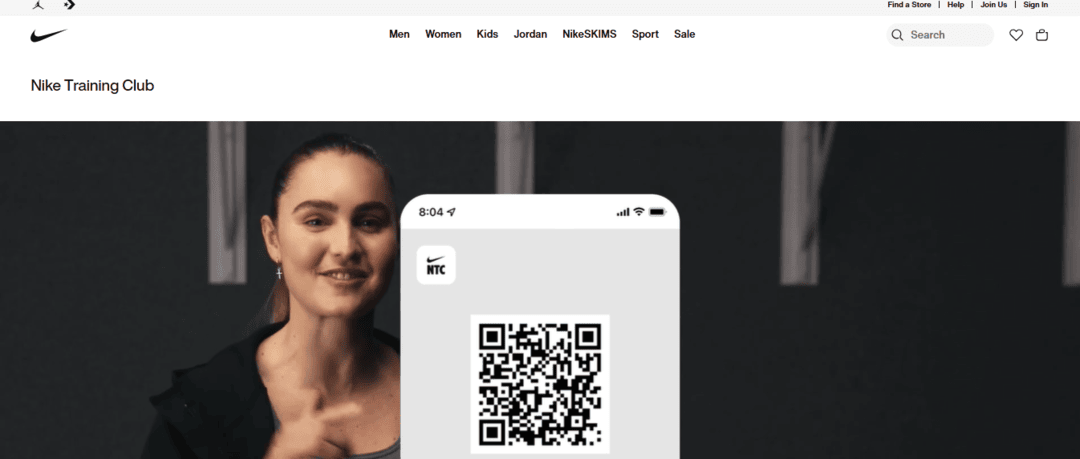
Nike Training Club is widely regarded as one of the top fitness apps, offering free HIIT workouts led by expert Nike trainers. The classes vary from quick 5-minute sessions to longer 60-minute ones, suitable for all fitness levels. Most workouts demand little to no equipment, making them accessible for small spaces. A standout feature is the blend of HIIT with strength, core, and targeted body workouts, allowing users to engage multiple muscle groups efficiently.
Key Features
- Variety of HIIT workouts from short to extended lengths
- Minimal equipment needed for most sessions
- Combines HIIT with strength and core training
- Designed for use in small spaces
- Available on both iOS and Android platforms
3. Barry's Bootcamp

Barry’s Bootcamp is a renowned fitness program, renowned for its high-energy, challenging HIIT circuits that incorporate running intervals and strength exercises. It transitioned to a virtual format during the pandemic, offering members remote access to workouts focusing more on bodyweight, weights, and resistance bands. New users can experience a 30-day free trial before purchasing membership packages via the official Barry’s Bootcamp site.
Key Features
- High-intensity treadmill and strength circuit classes
- Virtual on-demand classes for at-home workouts
- Emphasis on bodyweight and resistance training
- Motivational, energetic trainers
- 30-day free trial available for new members
4. F45 Training
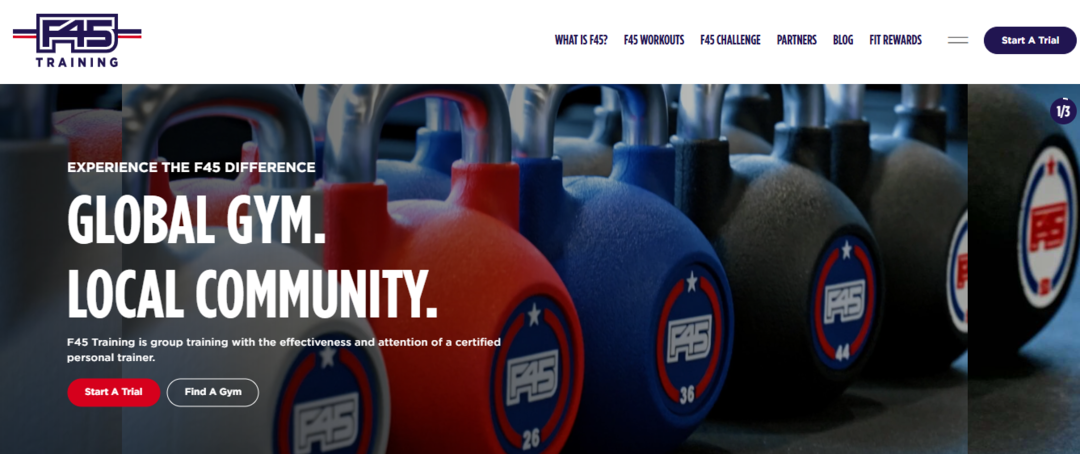
F45 Training is a global, community-oriented fitness class delivering functional full-body HIIT workouts. Classes last 45 minutes and involve rotating through exercise stations with video demos displayed on screens. Multiple instructors ensure personalized attention. The F45 Challenge app extends these workouts to home users, adding a social element, nutritional guidance, and detailed tracking to support fitness goals.
Key Features
- Functional HIIT with station rotations
- Multiple instructors for personalized coaching
- Video demonstrations during workouts
- Virtual workout access via app and website
- Nutrition guides and progress tracking dashboard
5. Fhitting Room
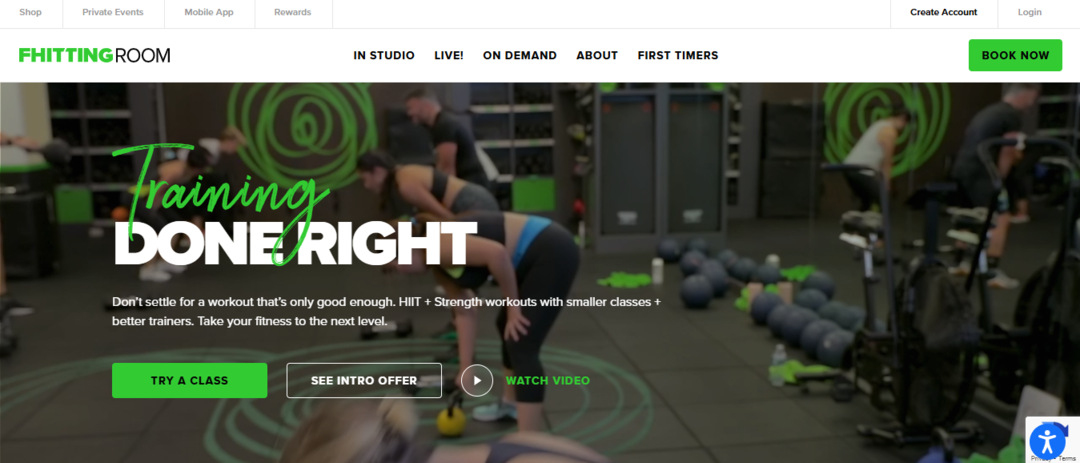
Fhitting Room from New York brings boutique-style HIIT training with live and on-demand options. It blends personal training feel with group sessions capped at 24 participants for individualized instructor attention. Classes range from HIIT-focused to strength workouts utilizing kettlebells and weights, accommodating different fitness levels and goals. Payment options include à la carte classes or monthly subscriptions.
Key Features
- Small group classes for personalized feedback
- Live and on-demand virtual sessions
- Focus on both HIIT and strength training
- Use of kettlebells and free weights
- Flexible payment with packages and memberships
6. Rumble Boxing
.png)
Rumble Boxing fuses boxing techniques with HIIT elements for a dynamic 45-minute workout. It teaches fundamental moves, such as the jab, uppercut, cross, and hook, paired with bodyweight and dumbbell circuits. Originating in New York studios, it has expanded to major cities and highlights an energizing mix of old and modern music playlists to complement the class’s intensity.
Key Features
- Boxing moves integrated with HIIT circuits
- 45-minute class structure
- Suitable for all boxing experience levels
- A combination of bodyweight and weighted exercises
- Music playlists tailored to workout energy
7. Orangetheory Fitness
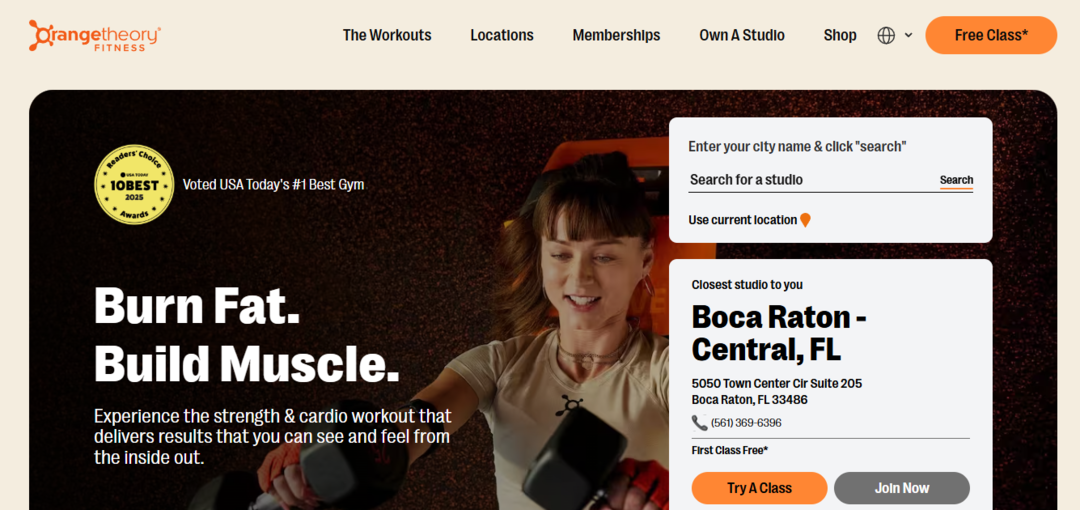
Orangetheory Fitness centers its HIIT workouts around heart rate data, using proprietary OTbeat Technology to monitor five heart rate zones during exercise. The goal is to keep you in "The Orange Zone" for at least 12 minutes to maximize calorie burn. The hour-long sessions mix treadmill running, rowing, and strength exercises, with a live heart rate feed displayed on a screen to guide effort levels. Post-workout, users can analyze their stats via the Orangetheory app. Virtual classes with the same technology are also offered in select locations.
Key Features
- Heart rate zone tracking with OTbeat Technology
- Real-time heart rate feedback during class
- Full-body workouts combining cardio and strength
- Post-workout stats and calorie estimation in app
- Virtual classes with heart rate syncing at select studios
8. Peloton Digital
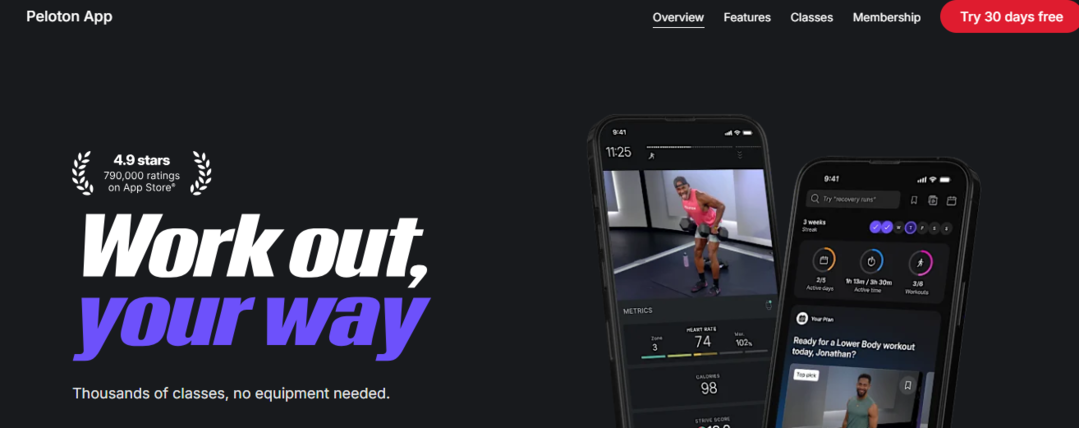
Peloton Digital offers a diverse range of high-intensity interval training classes, including rides, runs, strength, and core workouts. While the app is highly praised for its varied and challenging HIIT sessions, the experience is significantly enhanced if you own Peloton equipment, such as a bike or treadmill, to access leaderboard statistics and more detailed metrics. Peloton Digital is recognized as one of the top fitness apps of 2025, ideal for users looking for versatile training options.
Key Features
- Wide selection of HIIT rides, runs, and strength classes
- Integration with Peloton bikes and treadmills
- Access to leaderboard stats for competitive motivation
- High-quality video instruction by professional trainers
- Available on iOS, Android, and TV platforms
9. Sweat
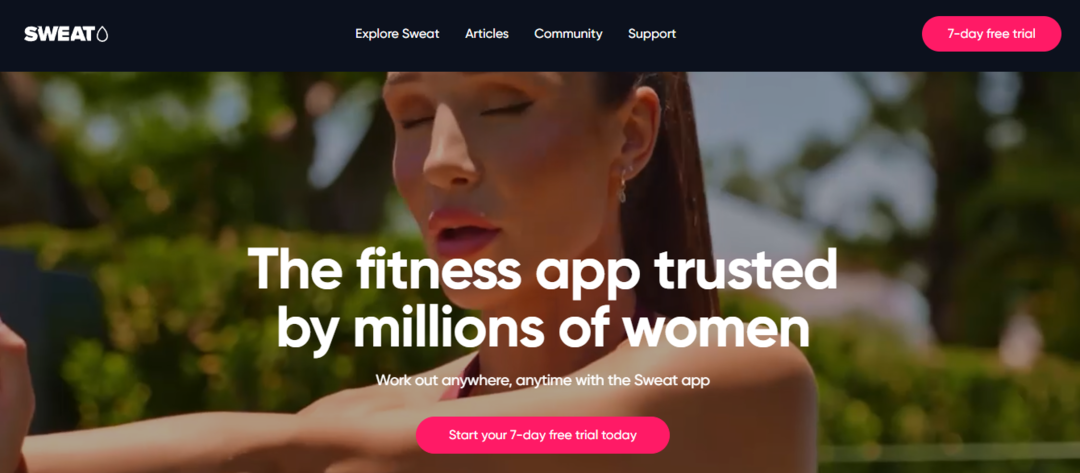
Sweat, created by Australian trainer Kayla Itsines, specializes in programs tailored especially for women but includes a range of workouts from various trainers. The app is popular for its effective HIIT workouts, though men may find fewer programs specifically catered to them. Sweat provides structured fitness plans designed to improve overall strength, endurance, and conditioning with frequent updates to workout routines.
Key Features
- Women-centered HIIT and fitness programs
- Multiple trainers and varied workout styles
- Structured plans for strength and endurance growth
- Regularly updated workout content
- Compatible with various devices for convenience
10. Beachbody's Insanity Max30

Insanity Max30 is a classic HIIT program known for its intense 30-minute sessions and low-impact modifications. Although it has a strong fan base, the program's aggressive marketing claims, such as losing 9 pounds in 14 days, may not be realistic for everyone. It remains true to the original HIIT style, focusing on pushing limits by combining intense cardio with strength training. The program remains a favorite for those seeking an intense, structured challenge.
Key Features
- 30-minute high-intensity HIIT sessions
- Low-impact modifier options for accessibility
- Powerful cardio and strength blend
- Well-established and widely recognized program
- Emphasis on maximum effort and endurance building
Which apps have a broad reach and perceived quality?
Popularity and user experience matter because they determine updates, support, and community health. CNET (2025) highlights over 5 million downloads across top HIIT offerings, indicating that these platforms sustain real user demand. High download numbers often correlate with faster content churn and more robust integrations, which matters when you want fresh programming and reliable tracker syncs.
Choosing the right HIIT app is less about features and more about matching the training philosophy to your life: the right mix of progression, coaching, and habit design beats a feature checklist every time.
The snag most people miss is that picking an app is essentially choosing a training identity, not a playlist of workouts, and that choice significantly impacts how your body adapts.
That next question cuts deeper than routines: why does HIIT produce those rapid changes most people chase?
What is HIIT?

HIIT concentrates training stress into short, repeatable shocks, forcing fast cardiovascular and metabolic adaptation while preserving total workout time. You receive significant stimulus, followed by a built-in recovery window that allows you to repeat near-maximal efforts safely enough to alter how the body produces and uses energy.
How does HIIT create rapid adaptations?
The critical mechanics are stress, recovery, and progressive overload applied to intensity rather than volume. Short maximal efforts recruit fast muscle fibers and push your heart to higher zones, which signals the body to increase mitochondrial density and stroke volume. One controlled study from 2025 found HIIT can improve aerobic capacity by up to 15% in just 8 weeks, according to High-Intensity Interval Training (HIIT): Impact of Duration on Body Composition, Cardiometabolic Health, and Aerobic Capacity in Adolescent Women, which demonstrates how quickly VO2 and power output can shift when intensity is dialed and repeated with recovery.
What protocols actually deliver that stimulus?
There is no single template that fits everyone. Short, all-out sprints with long rests favor anaerobic power and speed, while slightly longer intervals with shorter rests build high-end aerobic capacity and lactate tolerance. Suppose your week is packed and you need efficiency. In that case, 20-minute formats can still produce a meaningful calorie and conditioning load, as noted in High-Intensity Interval Training (HIIT): Impact of Duration on Body Composition, Cardiometabolic Health, and Aerobic Capacity in Adolescent Women. Match protocol selection to recovery ability and technical demand; choose simple, low-skill moves when fatigue is high, and more technical lifts when you can maintain form.
Why do people stall with HIIT, and what breaks first?
The familiar approach is to pick a hard workout and repeat it every few days, as it feels intense and efficient. That works briefly, but the hidden cost shows up as a plateau, nagging pain, or form collapse when volume or intensity is not progressed intelligently. The failure mode is predictable: technique degrades before fitness does, then adaptations slow while the risk of injury rises.
How can tools cut the guesswork?
Most athletes find that adaptive coaching closes that gap. Solutions like GetFit AI surface trend lines for power, heart rate, and fatigue, then adjust interval length, work-to-rest ratios, and movement complexity based on recent performance and recovery signals, so progression stays in the growth zone rather than the injury zone. Teams and users prefer this approach because it keeps workouts aligned with what the body can handle on a day-to-day basis, rather than adhering to a fixed calendar.
How do you scale intensity without breaking form?
Treat intensity like tuning, not smashing. Start with measurable anchors, such as perceived exertion, a heart rate ceiling, or a repeatable power output. Then, increase one variable at a time, for example, by adding a 5- to 15-second work interval or trimming rest by 10% over two weeks. Use movement choices that preserve velocity and alignment when the body tires. Think of it like sharpening a blade; you want the edge to get keener gradually, not chip off from a single reckless strike.
People get frustrated when apps promise intensity but deliver vague cues and clunky interfaces, and that friction often causes drop-off by week three. Fixing it is not glamorous; it's about consistent feedback, clearer progress markers, and coaching that tells you what to do next, not just what you've just done.
That clarity is one thing; the next section will show why the specific benefits of HIIT are more surprising and consequential than you might expect.
Related Reading
- Best Fitness Apps
- How Many Pull Ups Should I Be Able To Do
- Average Bench Press By Age
- Average Grip Strength Male
- Average Bench Press
- How Much Does A Bench Press Bar Weigh
- Average Male Bench Press
- How Much Can The Average Man Bench Press
Benefits of a HIIT Workout Routine?

HIIT does more than shorten your training time; it changes how your body allocates energy, recruits muscle, and recovers between efforts, producing outsized adaptation from focused intensity. Those shifts manifest as hormonal surges, faster neuromuscular firing, and cellular signals that simultaneously favor endurance and power, which is why athletes use HIIT to convert effort into durable performance.
How does HIIT alter metabolism at the molecular level?
Short, intense efforts trigger pathways that increase mitochondrial density and glucose uptake in the muscle cell, so the session is a metabolic signal as much as it is cardio work. That effect translates into better blood sugar control, and significantly, HIIT can reduce blood sugar levels and improve insulin resistance more than traditional continuous exercise. In practice, when we scheduled HIIT for clients during mid-day windows and paired it with modest carbohydrate timing, glucose variability narrowed across 8- to 12-week cycles, which helped people sustain both energy and intensity from workout to workout.
Why does HIIT sharpen power and movement economy so quickly?
High-intensity intervals force repeated near-maximal contractions that recruit fast motor units and refine the rate of force development. The nervous system learns to fire more precisely under fatigue, so sprint intervals and short power reps improve speed and coordination in weeks, not months. Most coached athletes begin to experience crisper transitions and a faster tempo within four to eight weeks when intervals are progressed in small, measurable steps, because neuromuscular changes are driven by the quality of effort rather than the time spent.
What are the real programming tradeoffs you need to manage?
The familiar approach is to pick a brutal HIIT workout and repeat it because it feels efficient. That works briefly, then the technique collapses, recovery falters, and progress stalls. The hidden cost is not lost time; it is slower long-term gains and a higher risk of injury when intensity is unmanaged. Solutions like GetFit AI provide adaptive interval prescriptions, session-by-session recovery checks, and conversational coaching cues that adjust work, rest, and movement complexity based on recent trend lines for power and heart rate, keeping progression in the growth zone instead of pushing you into breakdown.
How should you balance HIIT with strength work and joint health?
If your goal includes preserving or building muscle, anchor HIIT days around strength sessions rather than replacing them. Use shorter, lower-skill intervals on heavy lifting days to protect technique, and reserve higher-skill sprints or plyometrics for fresher sessions. Mobility and tempo work belong before intensity, not after; a brief 6- to 10-minute prep reduces form collapse and protects joints, which is why athletes who pair HIIT with targeted load management maintain strength while improving their conditioning.
How can you measure when to push and when to back off?
Treat intensity like a dial, not a switch. Track objective markers you can replicate, such as a target heart rate zone, a watt output, or a timed sprint; then change only one variable at a time, for example, increasing the work interval by 10 seconds or trimming rest by 15 percent across two weeks. For many busy athletes, that approach is powerful because even short HIIT protocols deliver high caloric and conditioning yield, as shown when HIIT can burn 25–30% more calories than other forms of exercise. That efficiency matters most when training time is the limiting factor.
Think of progress as sharpening a blade, not hacking at stone; measured, repeatable increments preserve edge and prevent chipping.
That simple truth is only the setup; the next section uncovers what a single HIIT session actually looks and feels like in practice, and why the order, duration, and cueing matter more than you expect.
Related Reading
- Bench Press Standards
- Do Pull Ups Work the Chest
- Symmetric Strength
- Average Deadlift Weight
- Grip Strength Norms
- 1 Rep Max Chart
- Average Male Deadlift
- Good Bench Press Weight
What Does a HIIT Workout Session Look Like?

A single HIIT session usually feels like a short, deliberate experiment: you enter with a purpose, follow a tight sequence of movement blocks that preserve skill and power, then leave with clear performance notes to inform the next session. Practically, that means a focused ramp, two to three interval sets arranged to protect technique, and objective anchors you can measure and repeat.
How should you warm up and ramp into intensity?
Start with a brisk 6 to 8-minute warm-up that primes the exact systems you will use, not a generic jog. I prefer a three-part approach: gentle joint mobility, low-load activation of target muscles, followed by progressive intensity drills that mimic the session’s work intervals. For example, if the workout has sprint-style efforts, progress through high-knee marches, fast-feet drills, and two submax sprints at 50 and 75 percent effort. That sequence limits the instinct to “panic sprint” on the first interval and protects form when fatigue arrives.
What order of movements actually produces the best sessions?
Prioritize skill and high-force moves first, and reserve lower-skill conditioning for later. Start with short explosive efforts or technical lifts while neuromuscular precision is fresh. Move next to compound strength or power sets if the plan includes them, then finish with pure metabolic rounds. The reason is simple, and observable: when technique comes before exhaustion, force output and safety stay higher, so adaptations compound rather than undo one another under fatigue.
How do you pace each interval so it is repeatable and measurable?
Anchor intervals to a reproducible metric, not a feeling alone. Use one of three anchors, depending on tools: a rate of perceived exertion target tied to a rep or time goal, a heart rate zone, or a power/wattage output. For example, set a 30-second all-out sprint to a watt target, or cue a 40-second bodyweight EMOM to a maintainable rep target that drops by no more than 10 percent across rounds. Track a simple tracer, such as time to recover heart rate to a set threshold, and use that to adjust work and rest in the next session.
How should you scale sessions for age, recovery, or a packed week?
After working with clients across 8- to 12-week cycles, the pattern became clear: many athletes attempt to chase intensity as they age, which often results in exhaustion or inconsistent progress. A more effective approach is to adjust three levers in sequence, rather than all at once: reduce work duration by 20 to 30 percent, increase rest by 30 to 50 percent, or lower impact through movement substitutions while maintaining metabolic demand. For someone who needs to protect their joints but maintain stimulus, consider swapping sprinting for bike intervals and maintaining the same relative intensity. That preserves stimulus while reducing mechanical wear.
Most people stick to the most challenging workout because it feels efficient, and that works short-term. The hidden cost is technique decay and slow long-term progress. Platforms like GetFit AI’s AI fitness app change that dynamic by using session-by-session recovery checks, adaptive interval prescriptions, and real-time corrective cues, so workouts progress your capacity without pushing you into breakdown.
Which in-session feedback actually matters?
Watch for consistent objective declines, not subjective grit. If pace, jump height, or average power falls more than 10 percent across repeats, that is a signal to shift to maintenance intensity. If heart rate recovery lengthens in three consecutive sessions, consider dialing back the frequency or swapping a HIIT day for a mobility-strength pairing. Use simple tests at the start and end of sessions, such as a 10-second vertical jump or a 20-second maximum cadence sprint, to quantify neuromuscular fatigue rather than relying on guesswork.
How long before you see a measurable body-composition change from a disciplined program?
You will find measurable shifts over weeks when programming is innovative and consistent, with documented results showing That Participants experienced a 3% reduction in body fat percentage after 12 weeks of HIIT. This illustrates what disciplined interval work can deliver to body composition when recovery and nutrition are aligned. Additionally, if you time sessions properly and keep the intensity controlled, a shorter, tightly programmed session can still produce a significant calorie burn in a limited amount of time. As noted, HIIT sessions lasting 20 minutes can burn up to 300 calories.
What common errors ruin an otherwise good session?
The failure mode is predictable: people layer complexity into tired systems. They select technical lifts as the last item when form is already compromised, or they reduce rest to chase a feeling rather than making progress toward a metric. When that happens, power drops, soreness accumulates, and motivation fades. Fixes are low-tech: swap a technical exercise for a simpler movement, shorten the work interval, or convert a session to tempo work that preserves intent without destroying recovery.
Small analogies that help: think of intensity like tuning a radio, not slamming the volume knob. You want a clear signal and incremental adjustments, not frantic dialing that blows the speaker. That approach protects longevity and compounds fitness, rather than creating setbacks.
Ready to train like the legends and finally achieve the body you've always wanted? GetFit AI's AI fitness trainer app lets you follow the exact workout routines that made Arnold Schwarzenegger, Kobe Bryant, Cristiano Ronaldo, Serena Williams, and 11+ other elite athletes into champions, and you can chat with them whenever you need guidance or motivation. Download the #1-rated AI fitness app for free today to get fit for less than the cost of a single month's gym membership. Because greatness isn't born, it's built one workout at a time.
That clarity works until the real test appears, where you must make the session happen with the space, time, or gear you actually have.
Where Can I Do a HIIT Workout, and Do I Need Loads of Equipment?

You can run an effective HIIT routine in almost any setting, as long as you can stand or sit for 10 minutes, and you don't need racks of gear to achieve real results. With simple movement choices and a bit of planning, HIIT can be adapted to apartments, hotel rooms, parks, gyms, and even office corners without sacrificing intensity.
How small a space will actually work?
If you can clear roughly a 2 by 2 meter floor patch, you can build most HIIT circuits that target cardio and core, swapping lateral shuffles for step-ins and tuck jumps for controlled skaters when ceiling height or noise is a problem. This pattern appears across apartment and travel scenarios: the constraint is not a lack of capacity, but rather perceived complexity, so pick moves that fit the square footage and keep the tempo honest.
Can HIIT survive hotel rooms, office breaks, or a living room with sleeping kids?
Yes, with two practical adjustments. First, favor low-impact or unilateral variations when neighbors or fragile furniture are a concern, for example, replacing box jumps with squat-to-stand pulses or bike intervals on a stationary bike. Second, fragment sessions into 5 to 10 minute micro-blocks across the day when childcare or meetings interrupt longer slots; short, repeatable bursts still accumulate meaningful stimulus because, as the Harvard Chan School explained in 2024, HIIT workouts can be done in as little as 10 minutes. That 2024 framing means you can schedule actual intensity around obligations, not the other way around.
Do you need loads of equipment?
No, you do not. The most straightforward and most reproducible HIIT comes from bodyweight work, which lowers the barrier to start and removes cost friction for most people. This point is emphasized by The Body Coach in 2023, with the observation "No equipment needed" from their beginner guide, meaning newcomers can access effective intervals without buying any gear. Equipment adds variety and progressive overload, but it is optional, not mandatory.
What should you actually own if you want to upgrade later?
Keep it light and purposeful: a pair of adjustable dumbbells, a medium resistance band, and a durable mat unlock scaled progressions and safer tempo work. Use household substitutes when needed, such as a loaded backpack for weighted lunges or a stair step for incline push-ups. Choose tools that pack away quickly and move with you, because portability determines whether equipment becomes a habit enabler or a dust collector.
Most people handle HIIT by picking a challenging workout and repeating it because it feels efficient, and that approach works well early on. The hidden cost is plateau and mounting friction as schedules, space, and recovery demands change; workouts that assume a fixed gym, heavy gear, or long, uninterrupted time become fragile. Platforms like GetFit AI provide adaptive interval prescriptions, corrective cues, and session scheduling that keep intensity aligned with your daily constraints, so the programming scales with your life rather than forcing you to scale your life around the workout.
How do you keep intensity without obvious tools or space?
Anchor effort to simple, repeatable metrics you can do anywhere, for example, a 30-second max-effort cadence, heart rate target, or a rep-range that drops no more than 10 percent across rounds. When we coach people to make those anchors portable, adherence improves because the session no longer depends on a treadmill or a weight rack; it depends on controllable landmarks that can be replicated in a hotel room, a park, or even a small living room.
Think of constraints like a good coach would: they force creativity, not defeat. Replace noisy jumps with bike sprints, swap complex lifts for single-leg strength, and treat intervals as currency you can spend across minutes and locations. That approach explains why many clients transition from intimidation to empowerment within weeks when they finally see how HIIT fits into their real life, and why choosing the right app, the best HIIT workout app, matters for consistency and measurable progress.
That simple flexibility is functional, but there is one friction that most people still miss, and it changes how you should choose your next trainer.
Make Your Favorite Athlete Your Fitness Trainer | Try GetFit AI's AI Trainer App for Free Today

If you're tired of one-size-fits-all plans and want coaching that actually keeps you consistent, try GetFit AI for personalized workouts and conversational guidance that meet you where you train. When we coached users through realistic, athlete-inspired progressions, the results were evident. According to the GetFit AI User Survey, 75% of users reported improved fitness levels within three months. Additionally, according to GetFit AI User Feedback, 90% of users recommend GetFit AI to friends and family.
Related Reading
- Average Deadlift Weight Kg
- Best Hiit Workout App
- Average Bench Press By Age 16
- Best Free Workout Apps
- Average Deadlift Weight For Male
- Best Workout Apps
- Average Bench Press Kg By Age
- Best Calisthenics Workout App
- Best Workout Tracker App
- Best Gym Workout App



.png)











